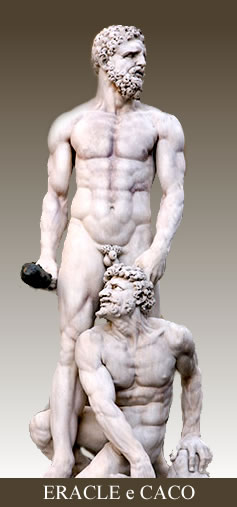The Hercules and Cacus myth

The Hercules and Cacus myth expresses the progressive insertion of the Hellenistic culture on the primordial Italic cultures: Hercules is the demigod, symbol of the courage and of the strength but also of the humanity and of the generosity, which contrasts with Cacus, monstrous and uncivilized shepherd generated by the God Volcano.
The Roman historians who relate the archaic events to us, try through the Hercules figure to put a continuum between the Greek civilisation and the Roman one, and therefore the demigod son of Zeus meets and fights with the Italic divinities that, if it does not manage to subject, it destroys.
According to the Greek myth, Hercules arrive in the Latium vetus after his tithe labour, with the oxen that it has taken from Gerion; he stopped to the temple of the Goddess Fauna - placed to the slopes north-east of the Aventino – for drink but the goddess refuses him the water because it is sacred and destine only to the women: Hercules full of rabies decides to build an altar for the sacrifices where the women it will be forbidden to enter: it will be this Ara Maxima of Hercules.
Intention to his work he not see a monster taken his oxen. The monster was Cacus, rough shepherd who lives on the Aventino, he drags the stolen oxen drawing them for the tail, so that the traces are confused. The moo of the stolen beasts makes understanding to Hercules where they are and entered into the cave without fear and crosses the fire rain that Cacus lunch with the mouth at him and Hercules, after having taken his enemy, grinds him.
The Latin myth is more complex: Hercules returning from the Hiberia with the oxen passes long the valley of the Tiber and there asks hospitality to Evandrus - son of Mercury and of the nymph Carmenta - head of the Arcadian community for a long time now installed on the palatine. The beautiful red oxens graze in the valley and Cacus, a monstrous shepherd who lives on the Aventino, steals them; Hercules goes retaking the oxen and kills Cacus. At this point who builds the temple? Will be Evandrus to thank Hercules of having freed them from the threatening Cacus presence.
From the rites of Hercules's cult the women were excluded why, according to what Lucio Cassio Emina transmits in his Annales Carmenta was not present during the sacrifice, the modern historians still put into relation the prohibition with the extreme virility of Hercules that as fertilised divinity was a danger for the chastity of the women.
The legend is based on the encounter between two myths, that darker one of Cacus and the one of Hercules, but guiding the comparison it is discovered that both are tied to the commerce of the salt and in general to the exchanges.
Cacus is a chief, a barbarian brigand who is incumbent over the road Salara and on the properties near the road, Hercules is the Etruscan Heracle and Hercules of the Sabine who protects the ancient road of the salt that from the Piceno gets out to the mouth of the Tiber.
Cacus and Hercules represent symbolically the evolution of the zone between Palatino and Aventino, close to the ford of the Tiber, which was the area of the commercial exchanges; the chronology sees Cacus (divinity of the permanent tribes of the middle bronze-age) chairing the protourban phase, when the inhabited place begins to spread also between Capitolium and Palatium and activities are born tied to the management of the ford and of the commercial exchanges with the ships that go up and down on the Tiber.
The Hercules cult arrives to the following phase with a little Phoenician community that institutes an own warehouse which Greeks and Etruscans use also; the warehouse was the guarantee of the commercial arrangements and it was unwinding his function behind the recognition of a tenth of the profits.
They are these foreigners to build the Ara Maxima of Hercules that was located really where the Foro Boario will rise then. It was a commercial sanctuary – datable around the IX century BC - and perhaps the most ancient temple of Rome dedicated to a foreign divinity; built on the land strip between Capitolium and Palatium the structure rise his height between the Velabrus and the Valley of Morcia (area of the Maximum Circus), where today there is the church of Santa Maria in Cosmedin who englobes the podium and a row of columns of the arcade. From the Ara Maxima of Hercules there were leaving the triumphs that were concluding to the Temple of Jupiter Ottimo Massimo on the palatine.
by M.L. ©ALL RIGHTS RESERVED (Ed 1.0 - 01/04/2015)






